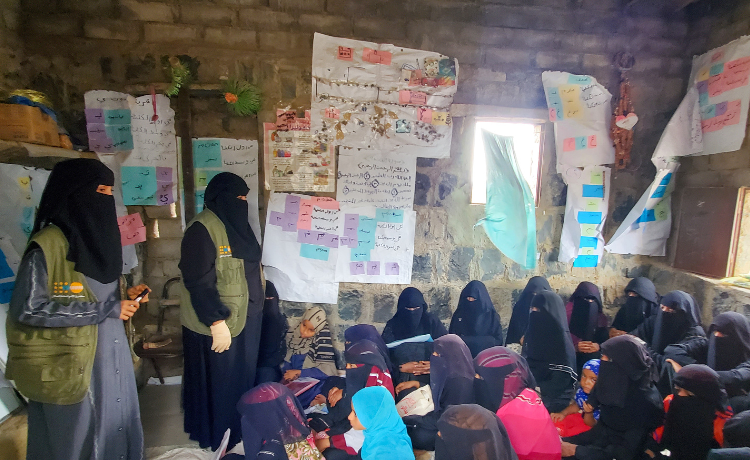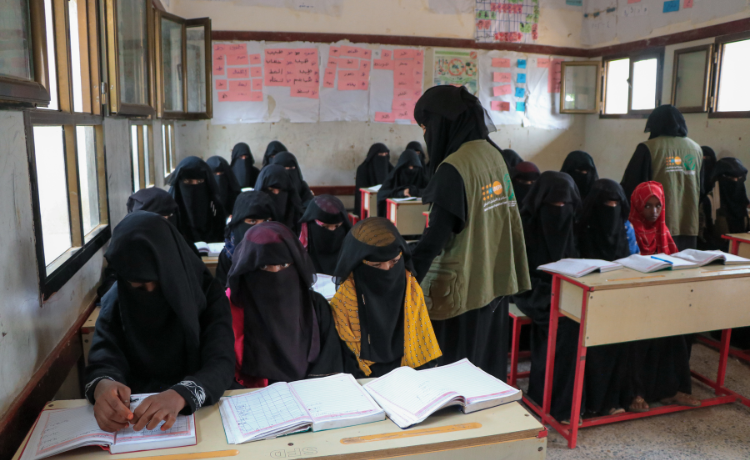News
Despite steep funding cuts, heroic teacher determined to keep girls in school and out of child marriage in Yemen
- 21 April 2025
News
HAJJAH GOVERNORATE, Yemen – “I strongly believe that girls impact the family: When a girl is educated, she can teach her sons and daughters,” said Aida Damoom, a 25-year-old teacher in Yemen’s northwestern Hajjah Governorate.
She was just 15 years old when the conflict erupted in 2015. Her father, the only breadwinner for their family of six, lost his job and their lives were thrown into turmoil. “I was the eldest child and became financially responsible for my family,” Ms. Damoom told UNFPA, the United Nations sexual and reproductive health agency.
Ms. Damoom decided she wanted to invest in the girls of her community, and studied to become a teacher. “What motivated me was the high levels of illiteracy among girls in the district,” she said.
In part due to the violence, poverty, insecurity and lack of social services in Yemen over the past decade, some 1.5 million girls are not in school. This not only blights their future learning and employment opportunities, but exposes them to higher risks of child marriage and adolescent pregnancy, and in turn potentially lethal health complications.
As part of the Joint UNFPA-UNICEF Global Programme to End Child Marriage, Ms. Damoom now gives literacy classes at a school in Al Hamra village to girls aged 8 to 19 – all of them survivors of child marriage. Almost one third of women in Yemen are wed before the age of 18, and there is no legal minimum age of marriage.
Dedicated to learning

In early 2024, Ms. Damoom’s classes were suspended when the school repurposed the classroom. Her students were devastated, but their teacher didn’t give up: Instead, she convinced her father to lend her a room in their home.
“My father always encouraged girls’ education, but he was fearful about the situation in the district. It took a week to convince him of the importance of reopening this class.”
Using her own salary, Ms. Damoom and her father refurbished the room and her students diligently attended classes there for more than six months. The numbers soon grew from 40 to 70 girls – too many to accommodate at her home, and through persistence she now has a permanent classroom back at the school.
“My role is to ensure girls complete their education and become literate, as well as to raise awareness about early marriage and encourage families to educate their daughters,” she said.
Child marriage in Yemen
A UNFPA study across three governorates showed that rates of child marriage were highest among displaced populations, with one in five girls aged 10 to 19 already married, compared to one in eight in host communities. One reason is that people who are displaced have fewer earning and educational opportunities as well as less access to health and social services, leading to greater vulnerability to harmful coping mechanisms and damaging social norms.
Child marriage leads to a range of tragic outcomes: More girls die from pregnancy and childbirth complications, there are higher numbers of unintended adolescent pregnancies, and girls often have to abandon their education and chances of joining the workforce. Overall, their future choices, health and well-being are vastly diminished.

As the conflict in Yemen enters its eleventh year, parents are increasingly resorting to marrying off young girls, as soaring poverty rates mean many feel they are left with no other choice. But Ms. Damoom is dedicated to offering a better one.
“When a girl is literate, she is empowered – she doesn’t need anyone to support her,” she told UNFPA. “Many girls have gone on to work or start their own businesses and support their families, which has changed the view of parents to marrying girls off early.”
Threat of funding cuts
UNFPA works with UNICEF and the Yemeni Women’s Union – the largest women-led organization in the country – on interventions to end child marriage. This includes Ms. Damoom’s literacy classes, which are also available to girls forced to abandon their schooling due to the conflict, displacement or violence at home.
Thanks to support from Austria, the European Union,Japan and Norway, the programme Ms. Damoom works under is currently reaching 738 girls in 22 classes across five governorates.
But a severe lack of funding for UNFPA’s response in Yemen means these classrooms now face closure. Already, recent terminations by the United States mean that 1 million women will lose access to reproductive health services, while 300,000 will no longer be able to access prevention and response services against gender-based violence.
As of this month, UNFPA’s appeal for 2025 of $70 million has received less than a quarter of the funding required to invest in the futures of Yemen’s women and girls.